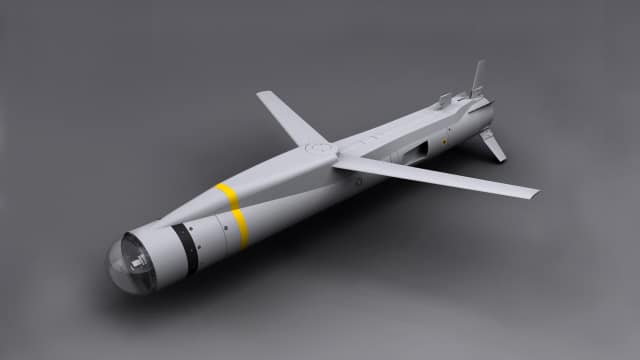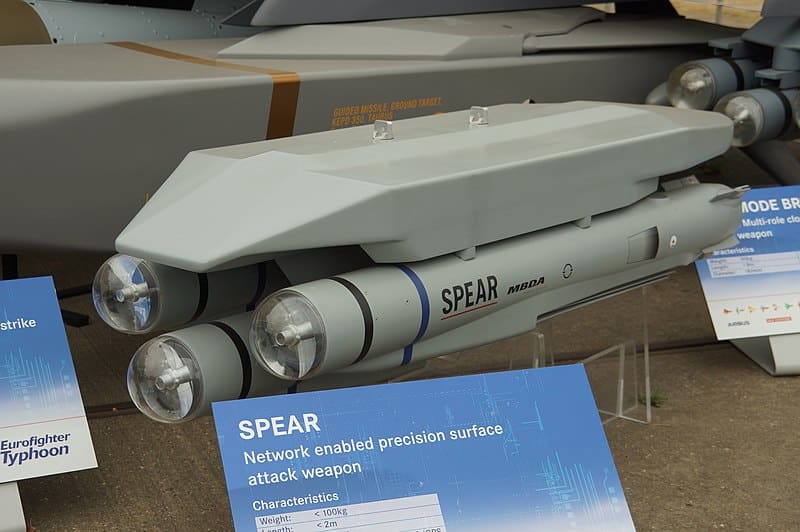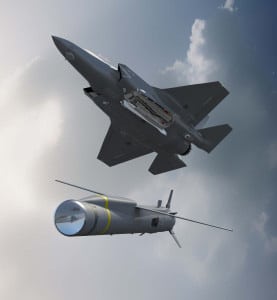The Selective Precision Effects At Range Capability 3 (Spear 3) missile is a member of the Brimstone family of cruise missiles. The land-attack and antiship air-launched cruise missile is designed to be internally carried by the F-35B Lightning II Joint Strike Fighter aircraft. Currently in development, the missile is scheduled to enter service in the mid-2020s.
SPEAR 3 at a Glance
- Originated From
- United Kingdom
- Possessed by
- United Kingdom
- Class
- Air-to-Surface cruise missile (land-attack & antiship capable)
- Basing
- Air-launched
- Length
- 2.0 m
- Diameter
- 0.180 m
- Range
- 120-140+ km
- Payload
- N/A
- Warhead
- Multi-effect (Tandem-shaped penetrating charge, high explosive/fragmentary)
- Guidance
- Inertial, GPS, Millimetric Wave and Semi-Active Laser seekers
- Propulsion
- Turbojet
- Status
- In Development
- In Service
- N/A



SPEAR 3 Development
The Spear 3, a follow-on to Paveway IV and Brimstone missiles (Spear Cap 1 and 2 respectively), is a 100 kg missile under development as the primary air-to-surface weapon for the Royal Navy’s F-35B Lightning II Joint Strike Fighter and the Royal Air Force’s GR4 Typhoon aircraft. The missile is designed to defeat mobile and relocatable targets, in all weather and day/night environments under tight rules of engagement that seek to minimize civilian casualties and damage to non-military targets.1
Requirements for the Spear 3 began to form following NATO’s 1999 intervention in Kosovo, after the UK forces struggled to strike time sensitive targets.2
While some of these concerns were addressed by the Brimstone missile once it entered service in the mid-2000s, in 2009 the MoD introduced the Capability 3 requirement to address Brimstone’s limited range and incorporate a two-way datalink that enables retargeting after launch.3
Even though Spear 3 will be deployed on the stealthy F-35B, which is designed to avoid detection on enemy radars, the missile was intended to provide a standoff capability (at least 100 km) to minimize the risk posed to the aircraft by advanced air defense systems, like the Russian S-400 Triumf.4
In March 2010, the UK awarded MBDA a four year Assessment Phase contract worth £150 million ($200 million).5 While the missile’s design in 2011 featured a box-shaped airframe, by mid-2012, MBDA had substantially evolved the design. When introduced at the Farnborough Air Show 2012 as a “mini cruise missile,” it featured “a new circular cross-section airframe (the same diameter as Brimstone), dorsally mounted flip-out wings (folding rearward for stowage), a revised intake arrangement with twin side inlets, and three folding tail surfaces in an inverted ‘Y’ configuration.”6
In May 2016, the UK MoD awarded MBDA a £411 million follow-on contract to integrate Spear 3 as part of a software upgrade for the F-35.7
In March 2016, BAE systems successfully test-fired Spear 3 trial missiles from a Typhoon trial aircraft at the QinetiQ Aberporth Range in western Wales. Spear program director, Paul Wester, said the test accomplished, “a variety of ‘firsts’ for Spear including the safe separation form the jet, commencement of powered flight, the maneuver whereby it rolled and opened its wing in free flight, navigation and the final simulated precision attack.”8 The total cost for missile development and integration with the F35 is expected to be £750-800 million (approximately $1 billion).9
The Spear 3 is scheduled to enter service in the mid-2020s.
Specifications
The Spear 3 is an air-launched cruise missile that can target air defense units, ballistic missile launchers, fast moving and maneuvering vehicles, main battle tanks, naval vessels, and armored personnel carriers.10 The mini cruise missile measures only 2 m in length and 0.180 m in diameter, but has an estimated range between 120-140 km.11
The missile is powered by a TJ-150 turbojet, and flies at high subsonic speeds.12
For midcourse guidance, the missile uses both an inertial navigation system and GPS to track its location and trajectory.
Like the Dual Mode Brimstone missile, the Spear 3 incorporates both a millimeter wave (mmW) and semi-active laser (SAL) terminal seeker for targeting flexibility. The mmW seeker enables “fire and forget” missions. The seeker captures images at 94 Ghz (near optical wavelengths), producing high resolution images for the system’s target recognition algorithms to evaluate without human intervention. The SAL seeker allows a human operator to “paint” a target for the missile using a laser. The seeker locks on to the laser’s reflected electromagnetic energy and flies itself to the target. Having these multiple seekers builds in mission flexibility, allowing the Spear 3 to be fired as an autonomous fire-and-forget missile or a laser-guided missile.
The Spear 3 also features a multi-effects warhead that can be programmed before or during flight. The new insensitive warhead, meaning a warhead that is resistant to environmental stressors that may cause it to explode (like bullet holes, extreme temperatures, etc), is versatile and “can produce a tandem shaped-charge effect against armour, blast/frag effect against soft vehicles, and a breach/penetrate effect for hardened structures and buildings.”13 In other words, Spear 3 can be deployed against many targets and be specifically tailored to achieve its desired effect based on mission-specific details in real-time.
The Spear 3 will be deployed on the F-35B Lightning II Joint Strike Fighter both in the internal weapons bay and under the wing. The F-35 can carry four Spear 3 missiles per launcher, one launcher for each weapons bay, and two additional launchers under the wings, for a total capacity of 16 missiles.14 Additionally, the missile has command air-burst and impact fuzing options that can be altered during flight as operators adjust to dynamic operative environments. The missile is also set to be fitted on the GR4 Typhoon aircraft, which will be able to carry three-round launchers on four underwing hardpoints, for a total capacity of twelve missiles.15
Footnotes
- “Spear Capability 3,” Think Defense, 2016, http://www.thinkdefence.co.uk/uk-complex-weapons/spear-capability-3/.
- “Aimpoint Selection: the UK’s SPEAR Cap 3 air-to-surface weapon,” Jane’s Defense Weekly, 2015, http://www.janes360.com/images/assets/853/47853/the_UK_s_SPEAR_Cap_3_air-to-surface_weapon.pdf.
- “UK Complex (Guided) Weapons—Reference,” Think Defense, 2016, http://www.thinkdefence.co.uk/uk-complex-weapons/.
- Andrew Chuter, “No UK Spear Cap 3 Decision on F-35 until 2018,” Defense News, May 27, 2015, https://www.defensenews.com/air/2015/05/27/no-uk-spear-cap-3-decision-on-f-35-until-2018/.
- UK Ministry of Defense, “£411 million investment in new missile for UK’s new jets sustain 700 UK jobs,” May 18, 2016, https://www.gov.uk/government/news/411-million-investment-in-new-missile-for-uks-new-jets-sustains-700-uk-jobs.
- Jane’s Defense Weekly.
- George Allison, “What is SPEAR 3 and Why is it so important?” UK Defense Journal, March 16, 2017, https://ukdefencejournal.org.uk/spear-3-important/.
- MBDAinc, “MBDA Showcase Spear Precision Strike Missile at Farnborough 2016,” https://mbdainc.com/mbda-showcases-the-spear-precision-strike-missile-at-f/.
- Jane’s Defense Weekly.
- George Allison.
- Andrew Chutner, “UK Backs MBDA on Mini-Cruise Missile Requirement,” Defense News, March 17, 2016, https://www.defensenews.com/home/2016/03/17/uk-backs-mbda-on-mini-cruise-missile-requirement/.
- David Donald, “Spear Sets Course for F-35 Integration,” AIN, July 13, 2016, https://www.ainonline.com/aviation-news/defense/2016-07-13/spear-sets-course-f-35-integration.
- Ibid.
- Ibid.
- Ibid.